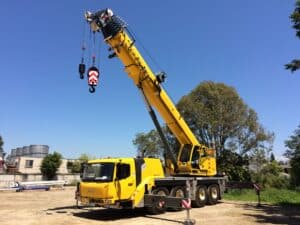Understanding The Important Role Of Engineers In Australian Crane Inspections

Crane inspections are crucial for maintaining safety, compliance, and efficiency across Australia’s diverse industrial sectors, ranging from construction and mining to logistics and manufacturing. At the core of this essential process are engineers, whose specialised expertise ensures that cranes remain safe and operational under stringent national standards.
This article explores the pivotal role engineers play in Australian crane inspections, emphasising their contributions to safety, regulatory compliance, and technological advancements.
The Legal and Regulatory Landscape of Crane Inspections in Australia
Overview of Australian Standards AS2550 and AS1418
The cornerstone of crane inspection protocols in Australia lies in the adherence to two critical standards: AS2550, which governs safe use, and AS1418, which addresses the design and performance of cranes.
These documents are enforced across industries and form the benchmark for what is considered acceptable operation and inspection procedures. Engineers are often the ones interpreting and applying these standards during inspections, translating technical requirements into practical outcomes on the worksite.
Engineering Credentials Required for Crane Inspectors
To legally conduct certain classes of crane inspections in Australia, particularly those involving load-bearing components or structural integrity checks, an engineer must possess a relevant qualification.
Usually, a degree in mechanical or structural engineering, and be registered under a recognised professional body such as Engineers Australia. In some states, additional certifications are required, particularly when dealing with high-risk plant equipment.
Compliance Obligations for Crane Owners and Operators
Employers and crane owners have legal obligations under Work Health and Safety (WHS) regulations to ensure that cranes are inspected by competent persons. In many cases, this “competent person” must be an engineer when the inspection exceeds the scope of routine maintenance and involves structural or mechanical evaluations. Engineers not only perform these assessments but also provide documented evidence that supports ongoing compliance.
Engineers as Key Stakeholders in Crane Inspection Processes
Structural Assessment and Load-Bearing Evaluations
Engineers bring a deep understanding of physics, materials science, and structural mechanics to the inspection process. They assess whether load-bearing components, like booms, jibs, and bases, are performing within safe tolerances.
Their evaluations ensure that cranes can handle the weights and operational stresses expected of them without compromising safety.
Identifying Wear, Fatigue, and Mechanical Integrity
Cranes are subjected to repetitive stress, extreme weather, and harsh environments, which can cause components to deteriorate over time. Engineers are trained to identify early signs of fatigue, corrosion, and mechanical wear that could lead to catastrophic failures if left unaddressed. Their diagnoses often involve a combination of visual inspections, mathematical modelling, and specialised testing.
Engineering Judgment in Risk-Based Decision Making
Not all inspection findings require immediate action. Engineers apply professional judgment to determine which issues pose immediate hazards versus those that can be monitored over time. This risk-based approach helps crane owners prioritise maintenance budgets while maintaining safety standards.

Types of Engineers Involved in Crane Inspections
Mechanical Engineers
Mechanical engineers typically focus on the moving parts, power systems, and mechanical integrity of cranes. They assess wear in gearboxes, wire ropes, motors, and braking systems, ensuring mechanical systems operate safely and efficiently.
Structural Engineers
Structural engineers assess the load-carrying framework of the crane. This includes analysing stress distribution, frame deformation, and structural fatigue. Their role is critical when cranes are used in high-load or high-risk environments, such as construction of high-rise buildings or offshore operations.
Specialist Inspection Engineers and Certifiers
Some engineers specialise in inspections alone. These individuals are often third-party certifiers who perform unbiased evaluations of crane systems. Their expertise is particularly valuable for annual or post-incident inspections, where impartiality and advanced diagnostic skills are essential.
Engineering Tools and Techniques Used During Crane Inspections
Non-Destructive Testing (NDT) Methods
Engineers use a variety of NDT techniques, such as ultrasonic testing, magnetic particle inspection, and dye penetrant testing, to identify subsurface defects without damaging components. These advanced methods provide accurate, real-time insights into the condition of critical parts.
Use of Digital and Sensor-Based Diagnostics
Modern engineers are increasingly relying on digital tools such as load monitoring sensors, vibration analysis devices, and thermal imaging to detect anomalies. These technologies allow for more frequent and detailed assessments, contributing to predictive maintenance strategies.
Engineering Reports and Documentation Standards
After inspections, engineers produce comprehensive reports detailing findings, methodologies used, and recommendations for repair or replacement. These reports are essential documentation for compliance audits and serve as the official record validating a crane’s operational fitness.
The Impact of Engineering Expertise on Safety and Operational Continuity
Preventing Crane Failures and Downtime
By identifying problems before they escalate, engineers help prevent unplanned breakdowns and costly repairs. Regular inspections led by qualified engineers ensure minimal disruption to project timelines and enhance overall operational reliability.
Enhancing Site Safety Culture Through Engineering Leadership
The presence of engineers during inspections often elevates the safety culture on-site. Their authority and technical knowledge instil confidence and encourage workers to take maintenance and safety more seriously.
Case Studies Where Engineers Played a Crucial Role in Inspections
Several incidents across Australia have highlighted the life-saving role of engineers. In one notable case, a structural engineer in Queensland discovered a cracked boom joint during a routine inspection, averting what could have been a catastrophic collapse on a busy worksite.
Training and Certification Pathways for Engineers in Crane Inspection
National and State-Level Certification Bodies
Engineers looking to enter the field of crane inspection must obtain recognition from national bodies like Engineers Australia, and in some states, they may need to be licensed through local regulatory authorities. Additional certification from third-party organisations like RPEQ (Registered Professional Engineer of Queensland) may also be required.
Continuing Professional Development (CPD) Requirements
To maintain their inspection credentials, engineers must regularly complete CPD hours. These often include courses in emerging technologies, updated standards, and advanced inspection methodologies.
Industry-Specific Training Modules for Crane Inspection Engineers
Many training providers offer specialised modules focusing on cranes used in unique environments, such as maritime, mining, or offshore platforms. These modules prepare engineers to tackle environment-specific challenges and inspection nuances.
Future Trends in Engineering-Driven Crane Inspections
Integration of AI and Predictive Analytics
Artificial intelligence is making headway in crane inspection. Engineers are beginning to leverage AI tools that analyse historical and real-time data to predict failures before they occur, enabling proactive intervention.
Remote Inspection Technologies and the Role of Engineers
Drones and remote sensors are increasingly being used for hard-to-reach areas. Engineers interpret data collected by these tools, enabling efficient inspections while reducing risks associated with manual assessments.
Evolving Standards and the Need for Multidisciplinary Expertise
As cranes become more complex, future inspections may require multidisciplinary engineering knowledge, combining mechanical, electrical, and software engineering skills. Engineers will need to stay ahead of regulatory changes and technological innovations to remain effective.
Final Thoughts on the Engineer’s Role in Australian Crane Inspections
Engineers play a central role in upholding the integrity, safety, and legal compliance of cranes in Australia. From detailed assessments and regulatory reporting to the application of cutting-edge diagnostic tools, their expertise ensures that crane operations meet the highest standards.
As industries evolve and embrace new technologies, the role of engineers in crane inspections will only become more critical, safeguarding not just equipment but lives and livelihoods across the nation.






